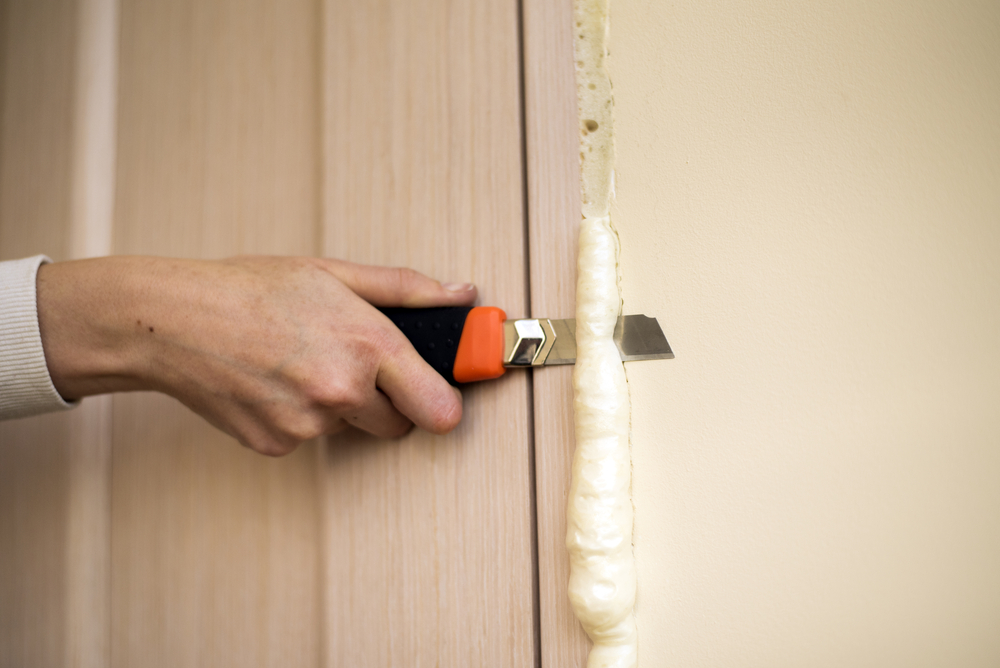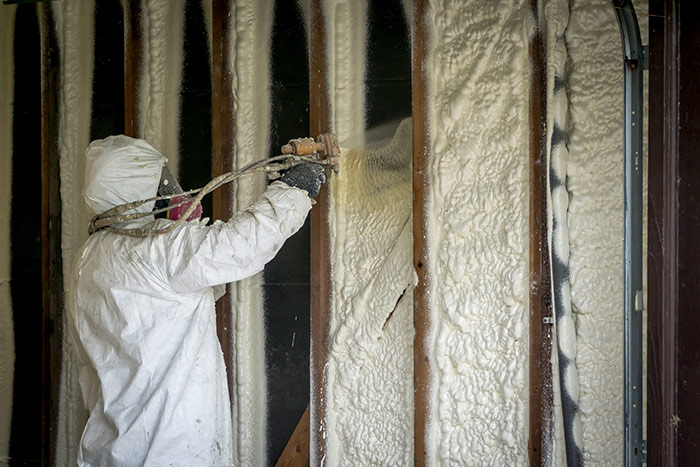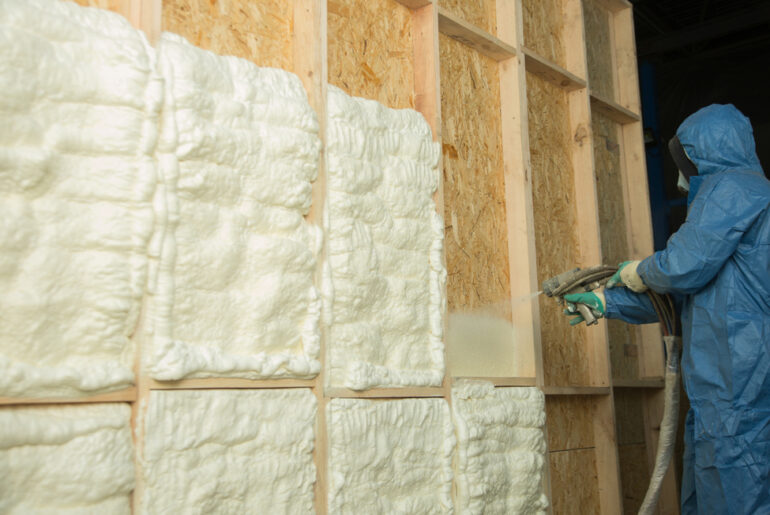After you’ve insulated the area you’re working on, the next step is to trim the spray foam. You can do this with a few different tools, but the most common and effective method is to use a utility knife.
But you also need to know how to trim spray foam, how long to wait before trimming, and whether or not you need to use a respirator.
We’ll discuss all these tips in this guide.
When to Start Trimming Spray Foam?
Before trimming excess spray foam insulation, you need to let it cure. Curing means that the foam will reach its final expansion and become hard.
The time it takes for spray foam to cure can vary, typically 8 to 24 hours. Initially, the material will take up to an hour to be tack-free. It means you can touch it without the material sticking to your skin.
During the first 24 hours, however, the foam is still expanding. This is why you need to be careful when trimming it. You don’t want to cut into the foam too early and cause damage.
It’s also important to note that spray foam off-gasses. That means that it gives off fumes that can be harmful if you inhale them. So you need to make sure the area is well-ventilated before trimming the foam.
The best time to start trimming spray foam is after it has cured for at least 24 hours. At this point, the foam will be hard, and you can start cutting it without damaging the material.
Some brands may have a longer or shorter curing time, so be sure to check the manufacturer’s instructions before trimming.
Safety Tips
If not handled properly, spray foam can be hazardous. Here are some safety tips to keep in mind:
- Wear gloves, a respirator, and eye protection when trimming spray foam.
- Avoid cutting into the foam too early. Wait at least 24 hours after spraying before trimming.
- Be sure to ventilate the area before trimming.
- Wear long sleeves and pants to avoid skin contact with the foam.
- Clean up any excess foam right away.
Some other safety tips will depend on the type of tool you use. For example, if you’re using a power saw, wear hearing protection.
If you’re using a hot wire cutter, be careful not to start a fire. Here are some other tips for using a hot wire cutter:
- Most hot wire cutters come with a guide. Follow the manufacturer’s instructions on how to use it.
- Be sure to have a fire extinguisher nearby in case of an emergency.
- Do not cut into the foam for more than a few seconds at a time. Let the cutter cool down in between cuts.
- Use a cutting board or another surface to protect your work area.
You may also use a utility knife or a sharp carving knife to trim the foam. Handle these tools with caution. You can trim your foam without any problems by taking the proper precautions.
How to Cut Off Excess Spray Foam? Step-by-Step
After the spray foam has cured, it’s time to trim off the excess. Here’s how to do it:
Step 1: Use a Utility Knife to Trim the Foam
Start by using a utility knife to score the foam along your cut line. Make the cuts deep enough so that you can see them.
Then, press the blade against the top edge of the foam and push it down. The blade will cut through the foam easily. Here’s how to perfect it:
- Slice the foam in small pieces.
- Keep doing this until it is flush with the wall.
- Keep the blade as flat as possible against the wall during this process.
You can use a flush-cut saw with a flexible blade if you don’t have a long-enough utility knife. It would be easily available at your local hardware store.
If the foam is too rough and doesn’t come off with a knife, you can use a metal scraper. Put the blade at a 45-degree angle and push it down.
When using a metal scraper, don’t put it perpendicular to the insulated surface. Otherwise, you might cut into it.
Step 2: Sand the Surface
The next step is to sand the surface until it’s smooth. You can use a power sander for this, but it’s not necessary. A hand sander will do the trick just as well.
If you’re using a power sander, start with a coarse-grit paper and then move to a finer one. If you’re hand-sanding, you can start with medium-grit sandpaper. Sand evenly so that the surface is smooth.
Step 3: Vacuum the Area
After you’re done sanding, it’s time to vacuum the area. It will remove all the dust and debris from the surface.
Step 4: Apply Caulk
The last step is to apply caulk around the perimeter of the trim to seal the area and prevent air from leaking.
Tools to Trim or Carve Spray Foam
You can use various tools to trim or carve spray foam, including a utility knife, foam saw, flush-cut saw, metal scraper, and a rotary tool with a carving bit. Here’s when to use each tool.
Utility Knife
A utility knife is the most versatile tool for cutting and shaping spray foam. It can be used to make straight cuts, curved cuts, and to score the foam (make shallow cuts that are easy to break along).
If you don’t want to rent a foam saw or spend time learning how to operate a rotary tool, you can use a utility knife to cut your foam. It’s not the ideal tool for the job, but it will get the job done.
Foam Saw
A foam saw is a specialized tool for cutting foam. It looks like a miniature hand saw and has very fine teeth designed to cut through foam without tearing it.
A foam saw is the best tool for making straight cuts in spray foam. It’s also the best choice for cutting foam along a curved line.
However, you may have to rent one or borrow one from a friend, as they’re not commonly found in hardware stores.
Flush-Cut Saw
A flush-cut saw is a hand saw that can make precise, straight cuts. It’s similar to a foam saw, but the blade is much thinner, and the teeth are much finer.
Rotary Tool with Carving Bit
A rotary tool with a carving bit can carve or sculpt spray foam. It’s not the best choice for making straight cuts, but it’s great for shaping foam and carving intricate designs.
Metal Scraper
You should only use a metal scraper if the foam is too hard to cut with a knife or saw. A metal scraper can also be used to remove any foam that is sticking to the tools or your hands.
For example, if you’ve used closed cell spray foam, it will cure (harden) quickly and will be very difficult to cut. In this case, you would need to use a metal scraper to remove the foam.
Saw blades
If you’ve insulated your space with open cell spray foam, you can use any type of saw blade. However, if you’re using closed cell spray foam, you’ll need to use a sharper saw blade to ensure a clean cut.
Closed cell spray foam saw blades tend to be more expensive than open cell saw blades, but they’ll save you time and frustration in the long run.
Should You Trim Spray Foam Yourself?
You can trim the excess insulation spray foam yourself with a utility knife, but it’s important to be careful not to cut too deeply and damage the underlying sheathing. It’s also a good idea to wear gloves and a long-sleeved shirt to protect yourself from the insulation spray foam.
However, it’s best to hire a professional if you suffer from a respiratory condition, as the fumes from the insulation spray foam can be harmful.
Additionally, if you’re not comfortable working with cutting tools, hiring a professional is probably best. Otherwise, you could end up damaging your home or injuring yourself.





